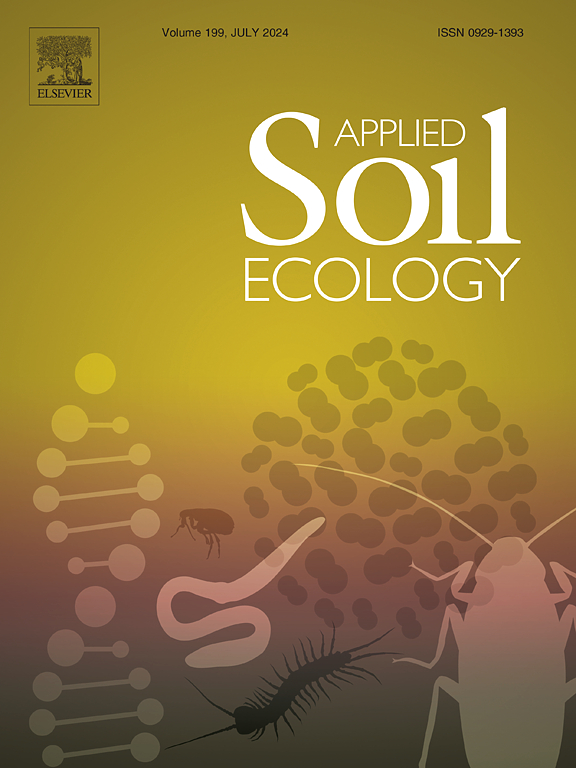Promoting soil microbial community development in early primary succession on waste rock by mulching with ramial chipped wood, in a boreal context
IF 5
2区 农林科学
Q1 SOIL SCIENCE
引用次数: 0
Abstract
The ecological restoration of mine waste rock corresponds to a context of primary succession, characterized by mineral substrates poor in organic matter and nutrients. The addition of organic matter, specifically in the form of ramial chipped wood (RCW) mulch, could facilitate the development of soil microbial communities crucial to ecosystem recovery on mineral substrates. This study examined the interaction between pioneer boreal tree species and soil microorganisms, exploring how a RCW mulch influences the development of microbial and plant communities in primary succession on different mineral substrates: waste rock and sand. The methodology of this research used an experimental design of four complete randomized blocks on an area composed of waste rock at the Lapa Mine, Quebec. Treatments (n = 4) included two mineral substrates (scarified waste rock or sand) with or without the addition of RCW. The study focused on seedlings of two tree species: Pinus banksiana and Betula papyrifera. Microbial community development was analyzed by metabarcoding, focusing on the rhizosphere of tree seedlings and bulk soil, five years after tree seedling establishment. After five years, RCW mulch boosted bacterial species richness and diversity, particularly around Pinus banksiana and on waste rock, although its effect on fungal diversity was less marked. RCW also favored the development of bacterial and fungal functional groups useful for plant growth. Microbial diversity was more influenced by the physicochemical properties of mineral substrates than by tree species, indicating a preponderant influence of the mineral substrate physicochemical properties during the very early microbial succession. By promoting beneficial bacterial diversity in pioneer trees, RCW appears to be a promising strategy for supporting ecological restoration in disturbed boreal environments.
在北方环境下,用木屑覆盖废石促进早期原生演替中土壤微生物群落的发育
矿山废石的生态恢复符合原生演替的背景,其特征是矿物基质缺乏有机质和营养物质。添加有机质,特别是以ramial chipped wood (RCW)覆盖物的形式,可以促进土壤微生物群落的发展,这对矿物基质上的生态系统恢复至关重要。本研究考察了北方先锋树种与土壤微生物之间的相互作用,探讨了RCW覆盖如何影响不同矿物基质(废石和砂)上初级演替中微生物和植物群落的发育。本研究的方法是在魁北克拉帕矿的一个由废石组成的区域使用四个完整随机块的实验设计。处理(n = 4)包括添加或不添加RCW的两种矿物基质(碳化废石或砂)。本研究以两种树种:松和白桦的幼苗为研究对象。利用元条形码技术分析了树苗建立5年后根际和散装土壤微生物群落的发育情况。五年后,RCW覆盖提高了细菌种类的丰富度和多样性,特别是在松周围和废石上,尽管它对真菌多样性的影响不太明显。RCW还有利于培养对植物生长有用的细菌和真菌官能团。与树种相比,矿物基质的理化性质对微生物多样性的影响更大,表明在微生物演替的早期,矿物基质的理化性质对微生物多样性的影响更大。通过促进先锋树有益细菌的多样性,RCW似乎是支持受干扰北方环境生态恢复的一种有前途的策略。
本文章由计算机程序翻译,如有差异,请以英文原文为准。
求助全文
约1分钟内获得全文
求助全文
来源期刊

Applied Soil Ecology
农林科学-土壤科学
CiteScore
9.70
自引率
4.20%
发文量
363
审稿时长
5.3 months
期刊介绍:
Applied Soil Ecology addresses the role of soil organisms and their interactions in relation to: sustainability and productivity, nutrient cycling and other soil processes, the maintenance of soil functions, the impact of human activities on soil ecosystems and bio(techno)logical control of soil-inhabiting pests, diseases and weeds.
 求助内容:
求助内容: 应助结果提醒方式:
应助结果提醒方式:


